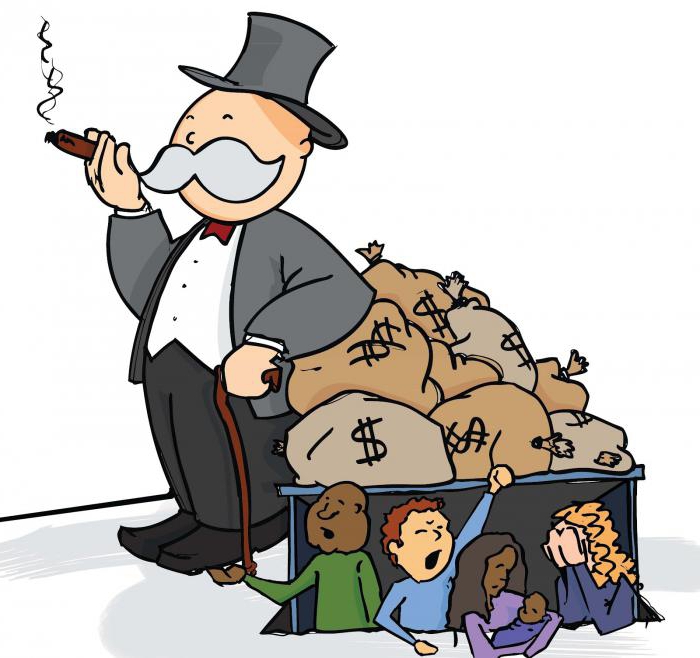Market structure is a complex concept that has many aspects. It determines the nature of the objects of transactions in the market. There are markets for services and products, factors of production (capital, labor, land), durable goods (more than a year) and non-durable (up to one year). When classifying market structures, one should rely on determining the nature of the product and the number of sellers.
Market structure
Market structure indicates the number of sellers and buyers, their share in the number of goods sold and purchased, the degree of standardization of products and ease of entry and exit from the market.

Perfect competition and pure monopoly are two extremes that have market structures. Only one company in a purely monopoly structure implements the entire offer of a particular product, the emergence of competitors is impossible.
Perfect competition is the exact opposite. In reality, the markets are between these two extreme cases. Nevertheless, marginal cases are useful for understanding many problems and for understanding the intermediate options that market structures have.
Signs by which markets can be divided, and their classification
The concept of "market" often implies a combination of many types and types of market which differ from each other in various ways. Their generally accepted classification is absent, but, despite this, markets can be divided according to certain criteria into groups: spatial, functional, organizational. The following groups are distinguished on the basis of organizational, that is, the degree to which competition is limited:
- perfect competition;
- the market is purely monopolistic;
- oligopolistic market;
- monopolistic competition.
Market Structures and Competition

Several market models are distinguished by the degree of monopolization (competition restrictions). Competitiveness is a very important factor that affects the behavior of consumers and manufacturers. It is determined by how much market participants can influence the prices of goods sold on it. The smaller this influence, the more competitive the market.
A brief description of the models can be represented as follows. A very large number of small firms exist in conditions of perfect (pure) competition. They produce the same (standardized) product, there are no barriers to penetration into one or another industry. In other words, the product can be released by any interested company.
The conditions of the market structure of a pure monopoly, on the contrary, imply the presence of a single firm, an undifferentiated product as a seller, as well as various barriers that exist in the way of manufacturers entering the industry.
What is characteristic of monopolistic competition? A fairly large number of large firms that produce a differentiated product (for example, shoes, clothes), as well as a fairly free entry into a particular industry.
Oligopoly is a market structure where a small number of large sellers operate, which can affect the cost of goods, the volume of supply. In addition, it is characterized by the difficulty of entering the relevant industry.
Classification of markets from the point of view of buyers

We note before considering in more detail various market structures that this classification is based on the number of sellers and their behavior. However, on the market, as you know, there are two entities - buyers and sellers. From the point of view of buyers and their numbers, the following types are distinguished:
- monopsony, in which only one buyer dominates the market and there are many sellers (a rather extraordinary situation, extremely rare);
- oligopsony, when there are several large buyers who can dictate their conditions to the market, as well as a competitive market with many buyers represented on it.
Classification of market structures is most often carried out on the basis of competition. From this point of view, there are 2 varieties - the market of perfect (free) competition, and imperfect, which is divided, in turn, into the oligopolistic, monopolistic and the market of monopolistic competition.
Perfect competition
The main features that define this market can be considered the following:
- many small firms that produce homogeneous (homogeneous) goods;
- the absence of any restrictions for the overflow of capital between sectors;
- complete information, perfect knowledge by manufacturers and consumers of the market;
- lack of price and consumer control on the part of consumers and producers.

Perfect competition takes place in fields of activity in which quite a few small buyers and sellers of the same (identical) product operate, therefore, none of them can affect its price. Price is determined here by the free play of supply and demand in accordance with the laws of the functioning of the market. The existence of a large number of sellers and buyers means that each of them has the same information about the market and finds the prevailing price level, which he cannot change, since the market dictates the price of the goods. This situation allows, on equal terms with existing sellers, to start new manufacturers to their activities. Producers, on the other hand, can leave the market and freely exit it. Freedom of movement means a constant change in the number of producers. The remaining sellers, at the same time, cannot control the market, since there are a lot of them and they are small participants.
Imperfect competition
Markets where either sellers or buyers can influence the price are called imperfectly competitive. For example, these are markets for cars, restaurant specialties, etc.
Individual sellers in imperfectly competitive markets can influence the price of the products they produce. Of course, in an effort to maximize profits, manufacturers take this opportunity into account. In practice, the most important features of the three types of markets with imperfect competition are: monopolies, oligopolies and monopolistic competition. On each of them there are, as in perfectly competitive markets, many sellers, and none of them can influence their own market economy.
Imperfect competition takes various forms. The classification of market structures related to it includes four main forms:
- Pure monopoly. In this case, production focuses only on one firm or corporation producing a particular type of product. Of course, the manufacturer can control very significantly the price of the goods.
- Duopoly. It happens when the production of a homogeneous product is carried out by two firms. Each of them can only partially control prices.
- Oligopoly. This is a market structure where a fairly small number of firms operate. Moreover, the ability to control prices is more limited than with a duopoly. Corporations (firms) produce homogeneous products with insignificant possible differentiation.
- Monopolistic competition. If available, there are many manufacturers who produce differentiated products, but homogeneous in terms of functionality. Differentiation can be both real and imaginary.There is very little control over prices.
Real market situations
From the foregoing, it is clear that market structures have two poles. The first is a perfect competition market. The other pole is pure monopoly. One and the other should be considered as very conditional. The fact is that real markets can be closer to the first or second pole. It is very difficult to recognize the existence of a pure monopoly. Indeed, for products manufactured by the monopoly, one can almost always find substitute goods (substitute).
In addition, in conditions of international open trade, you can buy a similar foreign product instead of a national product, which will be close to it. It is difficult to imagine, on the other hand, a market structure that corresponds to pure competition. The agricultural market is believed to satisfy its requirements. This is largely true. However, it is not easy with limited plots of land to meet the requirements of free entry into it. In addition, manufacturers in this market do not usually go directly to it. They work on exchange orders or on contracts.
Natural monopoly
Can be distinguished in connection with the foregoing natural monopoly. This is a pure monopoly, but at the same time caused not by artificial obstacles for entering a particular industry, but by reasons related to efficiency, when the activity of one company is obviously more effective than the presence of competing organizations. Many examples can be given of the natural monopoly: local supply of gas, electricity, telephone services, etc.
Pure monopoly

Describing the main market structures, let us say a few words about pure monopoly. This is a situation in which there is only one seller of goods that does not have close substitutes. Also, this term means the sole seller of this product. In sharp contrast with the competitive market is a market dominated by a monopoly. There is only one source of supply from buyers who want to buy the goods of a monopolist. This company has no rival sellers who compete with it in the market.
Pure monopoly as a concept is abstract. There are very few products (if any) that cannot be found as substitutes. For example, the postal service is only at first glance the only provider of mail delivery services. However, they can be replaced by telecommunications, including electronic messaging, as well as an express delivery service.
Oligopoly
We continue to describe the types of market structures. Oligopoly implies the presence of a small number of producers of goods on the market, acting together. A characteristic feature is that they are few in number and can individually affect the market. Duopoly is the simplest case of oligopoly.

Oligopoly of the 1st and 2nd type is distinguished. The oligopoly of the first kind is otherwise called pure. It has industries in market structures characterized by large enterprises and completely homogeneous products. An example is oil companies. Differentiated, or the second type of oligopoly, is a market structure where there is a differentiated product sold by several manufacturers. We turn to the description of monopolistic competition.
Monopolistic competition
Highlighting the types of market structures, it should also be noted monopolistic competition. It is carried out when many sellers compete with each other in order to sell a differentiated product on the market, and new manufacturers may appear.

The following characteristic features of monopolistic competition can be distinguished.
- A product of a company trading in the market is an imperfect substitute for goods sold by other manufacturers.
- There is a fairly large number of sellers, while each of them satisfies a small, but at the same time, not a microscopic share of demand for a particular type of product. The size of the shares of firms in monopolistic competition exceeds 1%. Each of them typically accounts for from 1 to 10% of all sales in the market.
- Sellers acting on the market do not take into account the reaction of rivals when choosing what price to set for their goods, or when determining the volume of annual sales.
- There are conditions for free entry and entry into the market of various manufacturers. New sellers are attracted by favorable conditions. Meanwhile, entering the market is not very easy, as with perfect competition. New sellers often experience difficulties with services and brands that are new to customers. Consequently, firms with an established reputation have the opportunity to maintain an advantage over new competitors.
These are the main market structures. As you can see, there are quite a lot of them, and some of them are not found in their pure form. The market and market structures are the main topics in the economy, so they should be studied as best as possible.






